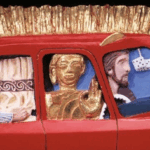Review: Australia’s Vietnam: Myth vs History by Mark Dapin
Australia’s Vietnam veterans, many of whom afterwards couldn’t fit in and went bush, faced a rigged ballot that meant the government chose who would fight in Vietnam, in a war the public quickly turned against. When the veterans returned home they received a hostile reception from the general public and the RSL, which preferred the world war veterans, and, unlike those world war veterans. Vietnam vets received no welcome home parades. Instead they were flown back at night to try and avoid airport demonstrations, where protesters were angry at the reports of atrocities committed by Australian troops. Protesters would throw red paint on the vets and called them ‘baby killers’.
Or so the story about Australia’s Vietnam War often goes, but Mark Dapin suggests that all the above is mythology, borrowing from fiction and the American experience, being misremembered and misreported in books (including his own, he confesses). He refutes each of these points by simply checking newspaper reports and military records, as well as pointing out the logical improbability of some of the myths. Isolated incidents have become widespread phenomena, nuances have been edited out and what might have happened has become what did happen.
For example, regarding the supposed military policy of avoiding airport demonstrations by flying home in the middle of the night, Dapin suggests that large airport demonstrations would have been front-page news. There were some claims of hundreds of vets and protesters clashing. But media outlets of the day reported nothing, even when they diligently reported the minor presence of protesters at parades. Dapin has a wry sense of humour and he notes that when one veteran was questioned about the ‘huge’ demonstration he faced at the airport, the vet admitted it was three people who may or may not have been protesters.
Dapin, a chronicler of Vietnam stories in other books, is not critical of veterans, though. He is highly sympathetic, arguing that the mire of Vietnam understandably contributed to the feeling that the public had turned against them. It is understandable that anger has focused on the actually rather small anti-war movement, who are generally caricatured as greasy hippies. The fact that the anti-war movement was overwhelmingly sympathetic to vets, seeing them as victims of government intractability, has been lost over time, he says. The evidence suggests protesters wanted to prevent soldiers leaving for war, not harass them when they returned.
Veterans did indeed receive welcome home parades, the size of which outdid the much-publicized Moratorium marches. Beyond individual scraps which have led to Vietnam veterans being banned from particular clubs, the RSL was also generally supportive of veterans. Dapin suggests reports of the RSL pressuring the Army to prevent Vietnam veterans from marching on Anzac Day are simply conspiracy theories.
The trauma of war understandably exacerbated fallible memories, which, Dapin notes, we all share, and the uncritical regurgitation from historians of unattributable quotes has helped cement the mythology. He is repentant about his own recycling of stories and surprised at the lack of fact-checking. Veterans and journalists tend not to deliberately lie, he says. But truth is the first casualty of war and myths take on a life of their own. They are like zombies, he laments, almost impossible to kill.
Some veterans are inevitably going to be displeased that their testimonies are shown up to be inaccurate, and it is good to remember that absence of evidence is not evidence of absence. But Dapin is careful, separating feeling and fact, not dismissing recollections, making distinctions between the emotional experiences of veterans and the tasks of historians. He accepts that remembrances tell us something important even if they deviate factually at times. But he believes some of the myths do veterans a disservice, hiding the important individual, varied stories of veterans. For example, Dapin reinforces that it is not simply a matter of veterans being for or against the war. Some veterans came to respect the military even though they were at first oppositional; others went to war convinced of the moral correctness of Australia’s position only to be dissuaded. Veterans, as we all should, make distinctions between war, soldiers and the governments that make war.
While veterans, especially the bikers, have a reputation for secrecy and belligerence, Dapin finds them to be overwhelmingly open and caring, even if many also live with trauma that affects their relationships and their ability to cope with life. He constructs a complex picture of veterans and their experiences, and argues that mythologies flatten this complexity by, for example, unfairly portraying all protesters as hostile to veterans or tarring all veterans as happy to murder civilians. Mythologies don’t help the Australian public understand our complex history, and they can legitimise the making of war by those in power who typically avoid becoming veterans themselves.
Nick Mattiske blogs on books at coburgreviewofbooks.wordpress.com












